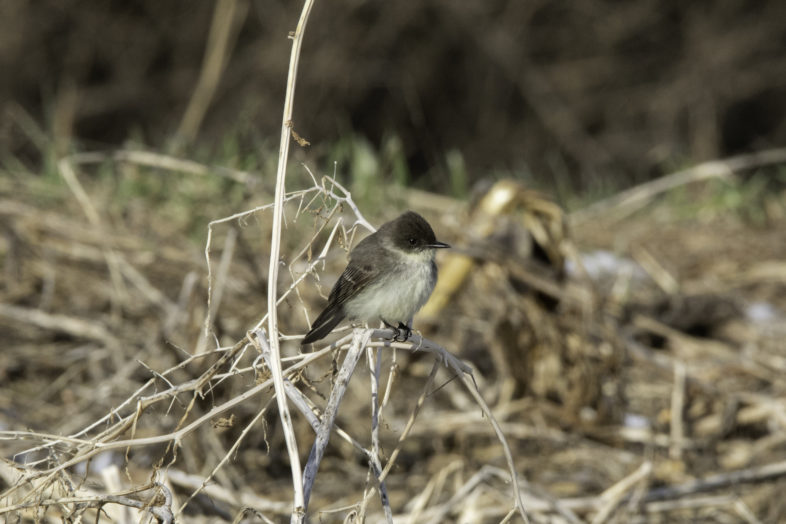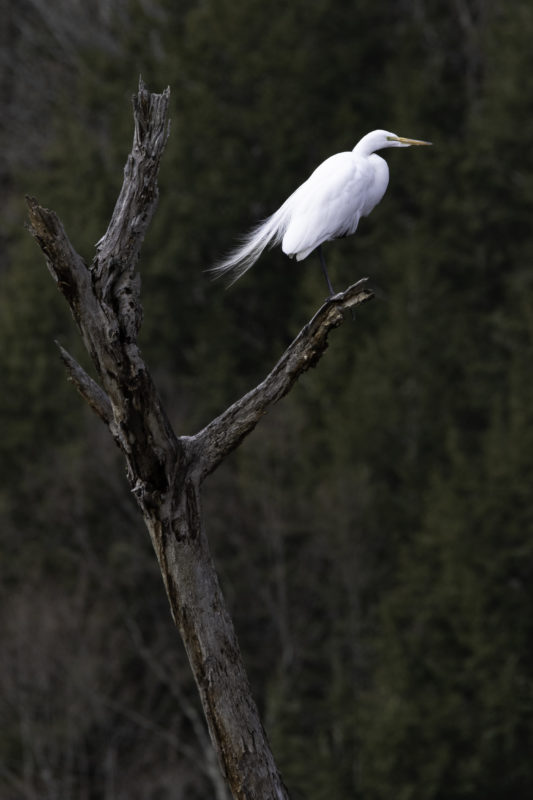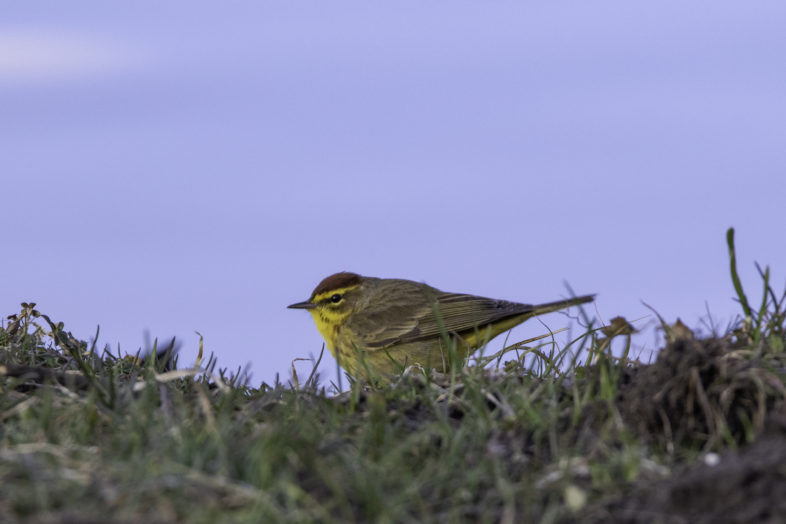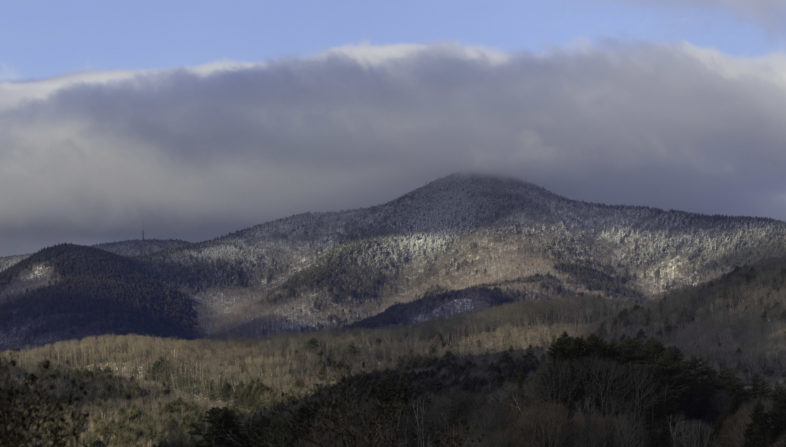
One of >125 food-stressed Eastern Phoebes concentrated around Lake Runnemede on 18 April 2018. © Kent McFarland.
Despite persistent grumblings about the glacial pace of spring 2018, our recent stretch of cold, raw weather has produced memorable birding in Vermont’s Upper Valley. As ground-foraging songbirds have swarmed feeders, other species have sought sustenance in unlikely places, often near water. Unusual concentrations have resulted, some of them unprecedented.
Kent McFarland, Spencer Hardy and I had a morning we’ll long remember at Lake Runnemede in Windsor on April 18, more for numbers of several migrants than for diversity of species. Most phenomenal was the multitude of Eastern Phoebes. Many birders had observed unusual numbers of phoebes along the Connecticut River during the previous few days, as weather-stressed birds hawked insects on or over exposed mud flats and shorelines. Seeing up to 10 birds at a single site became the norm. The concentration we witnessed at Runnemede blew those numbers out of the water. Though it sounds fanciful, we counted no fewer than 125 individuals!! Birds literally swarmed the shoreline and dominated the corn stubble. At one point, I counted carefully with my scope along a ~250-yard stretch of lakeshore and tallied 75 phoebes. Several minutes later Spencer counted 31 birds teeing up on corn stubble and weed stalks in the big central field. There were easily another 15-20 birds along the shoreline and main dike on the lake’s eastern section. It was truly mind-boggling!
Wondering if our numbers might be verging on uncharted territory, I searched eBird to determine all-time individual high spring (March through May) phoebe checklist totals across New England and NY. High counts for those seven states ranged from 19—71 birds, averaging 40.3 birds. Our count of >125 phoebes obliterates any earlier eBird records from the Northeast! Interestingly, none of us heard any of the birds utter a single call, let alone song, during our observations (granted my hearing isn’t what it used to be…) — they were too intent on foraging. It was an experience not to be forgotten.
While phoebes far and away stole the show, we encountered other notable birds. Highlights among our 55 species included:
Blue-winged Teal 3
Green-winged Teal 5
Ring-necked Duck 54
Lesser Scaup 5
Bufflehead 5
Hooded Merganser 2
Common Merganser 30
Pied-billed Grebe 2
Great Blue Heron 4
Great Egret 1

A Great Egret in breeding plumage at Lake Runnemede. The species isn’t known to nest (yet) in the Connecticut River Valley of VT or NH, but it has become increasingly common in recent years. © Kent McFarland
Broad-winged Hawk 1 Overhead views of an adult being persistently harassed by a crow
Virginia Rail 1 Heard giving ‘grunt’ call, then seen scurrying furtively in a Phragmites stand
Wilson’s Snipe 1
Yellow-bellied Sapsucker 1 drumming
Northern Flicker 15
Eastern Phoebe 125 Staggering concentration!! And almost certainly undercounted.
Northern Rough-winged Swallow 6
Tree Swallow 30
Carolina Wren 2 singing
Ruby-crowned Kinglet 6
Eastern Bluebird 2
Hermit Thrush 4
American Robin 25
Palm Warbler (Yellow) 15

A Yellow Palm Warbler, one of 7 foraging together along the grassy dike at Lake Runnemede, 18 April 2018. © Kent McFarland
Yellow-rumped Warbler (Myrtle) 8
American Tree Sparrow 2
Field Sparrow 2
Fox Sparrow (Red) 2 (1 singing)
Dark-eyed Junco 5
White-throated Sparrow 2
Vesper Sparrow 3 In corn stubble with Savannahs
Savannah Sparrow 60 Undoubtedly a low count; most birds in corn stubble
Song Sparrow 60 Probably a low count; ubiquitous
Swamp Sparrow 3 singing
Rusty Blackbird 10
Evening Grosbeak 1
Purple Finch 1
Pine Siskin 1
Bad weather birding presents us humans with a conundrum. While the adverse conditions often concentrate birds in conspicuous places and reduce their timidity — which leads to exciting encounters for birders — the consequences for survival can be grim. Our delight and awe at seeing grounded migrants must be tempered by concern for their welfare; our experience with the Runnemede phoebes was a case in point. Although this is a notoriously hardy species among insectivorous songbirds, the epic congregation we witnessed reflected a stressful situation for the phoebes, some of which may have been soon-to-be local breeders, others northbound migrants. We can only hope that they eked out the tough conditions and are now facing less demanding times. Not that it’s ever easy to be a phoebe…


Wow, what an awesome count. Nice photos Kent. Nice article Chris.
It was a crazy morning for sure. I have never seen so many of them in one place. It must have taken a toll on them. Our phoebe here at the house was singing before the storm and then during the storm I saw him one time all puffed up. Since then, silence. He has disappeared. I am afraid he might not have made it through that rough weather spell.
Have had many phoebes here near the house but some were calling a couple of days ago…also have a hermit thrush…juncos have subsided somewhat..along with a good group of evening grosbeaks. Jo-Ann Ecker